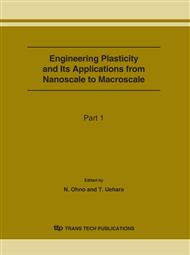p.997
p.1003
p.1009
p.1017
p.1025
p.1031
p.1037
p.1043
p.1049
Numerical Evaluation of Micro- to Macroscopic Mechanical Behavior of Plastic Foam
Abstract:
In this study, we employ the two-dimensional homogenization model based on molecular chain network theory to investigate the micro- to macroscopic mechanical behavior of plastic foam under macroscopic uniform compression. A parametric study is performed to quantify the effect of a characteristic value of matrix, distribution and initial volume fraction of voids, and the macroscopic triaxiality of loading condition on the deformation behavior of the foam. The results suggest that the onset of localized shear band at the ligament between voids together with the microscopic buckling of the ligament leads to the macroscopic yield of the foam. The initial modulus and the macroscopic yield stress of the foam have no dependence on the characteristic value of matrix. Furthermore, as the microscopic buckling of the ligament is promoted in case of high initial volume fraction of voids and high triaxiality loading condition, the macroscopic yield point appears at early deformation stage. After the macroscopic yield, macroscopic strain hardening appears in the macroscopic response and a remarkable strain hardening is shown in case of high initial volume fraction of voids and high triaxiality loading condition due to the considerable increase of the density of the foam in these cases.
Info:
Periodical:
Pages:
1025-1030
Citation:
Online since:
June 2007
Authors:
Price:
Сopyright:
© 2007 Trans Tech Publications Ltd. All Rights Reserved
Share:
Citation:


